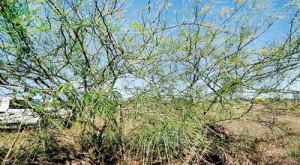Beware! Parkinsonia is no innocent weed
Parkinsonia scientifically known as Parkinsonia Aculeata is an invasive species in the world. My recent visit to Sri Lanka provided me the opportunity to locate a small infestation of Parkinsonia about 10 km north of Anuradhapura where the climatic and soil conditions are ideal for this invasive plant found in Queensland, Australia and where it is listed in Weeds of National Significance. This species is not well known to Sri Lanka and not considered as a weed so far.

Parkinsonia plant with flowers - Anuradhapura
Some of the common names are Jerusalem thorn, sessaban, horse bean, jelly bean tree, Barbados flower-fence.
The introduction of Parkinsonia to Sri Lanka could be for an ornamental purpose as it was introduced to Queensland, Australia in the late 19th century as an ornamental plant and as a shade tree for planting around waterways, dams and homesteads.
Parkinsonia has been introduced into many regions worldwide, including Hawaii, tropical Africa, India, Pakistan,the Middle East, Italy and Cyprus.In Australia infestations occur mainly throughout coastal, central and western Queensland, central and Northern Territory, and the Kimberley and Pilbara regions of Western Australia. At least 800,000 to one million ha of lands are now infested with parkinsonia plants in Australia.
The native range of this species is Southern USA, Northern Mexico, the Galapagos Island and Northern South America, Bolivia, Peru, Paraguay and northern Argentina.
Parkinsonia is an upright (erect) spiny shrub or small tree often forming dense thickets. It can reach up to 10 m tall but usually grows 2-6 m in height. The branches are green in colour, hairless and are often drooping or have a zigzag appearance. Younger stems have a pair of sharp spines (3-20 mm long) below each leaf and these remain on older stems after the leaves have been shed.
The fruit is an elongated pod that is swollen around each of the seeds. The pods (3-13 cm long) turn a light brown or straw colour when mature. Usually it contains 1-6 seeds (occasionally up to 8 seeds). The relatively large seeds are somewhat oval or oblong in shape, olive green to brownish in colour and are sometimes mottled. They have a thick and extremely hard coat and can remain viable in soil for many years.
Parkinsonia reproduces mainly by seed but it can also produce suckers particularly after it has been damaged. The seeds are mostly spread after being eaten by birds and other animals. The pods also float in water and the seeds can be dispersed in mud that becomes attached to animals and vehicles.
Pakinsonia is a fast growing plant and can flower as early as its second year of growth.
Parkinsonia can threaten grasslands, farming lands and wetlands in dryer areas of Sri Lanka. If left untreated, it displaces native vegetation and reduces access to land and waterways.
The environmental impacts of parkinsonia are numerous. Native plant species are replaced, leading to lower quality habitat for animals.Wetlands are particularly vulnerable because parkinsonia can damage watercourses, cause erosion, lower water tables and take over vast tracts of floodplain. Threatened areas include national parks and other regions of high aesthetic, indigenous and tourist value.
(The writer is an Invasive Plants Specialist based in Queensland, Australia)


